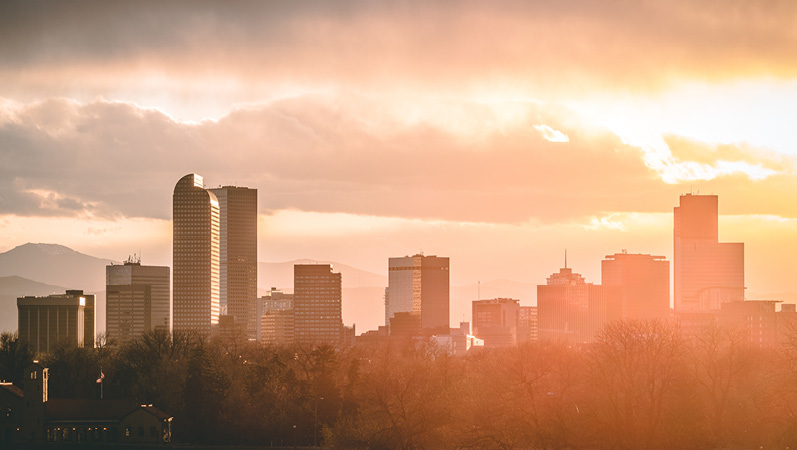While we’re still in stay-at-home mode here in Denver, it’s good to brush up on local knowledge. There’s fascinating trivia and fun facts about our city that every resident needs to know.
Are you a newcomer to Denver? Or, have you been here for decades but need new material to impress relatives and friends at the next (hopefully soon) get-together?
Below you’ll find some great conversation starters to show your newfound (or refreshed) knowledge of the Mile High City. These 10 fun facts about Denver reflect both history and current trends which make our city special.
Have fun and be sure to check out some of the businesses, attractions and landmarks listed below. For those that are currently closed, hopefully they will soon be reopened for us to enjoy.
#1: Denver Has Kansas Roots
Back in the 1850s when Colorado was part of the Kansas territory, General William Larimer established a settlement near the confluence of Cherry Creek and the South Platte River. Hoping to gain favor with Kansas Territorial Governor James Denver, Larimer named the enclave ‘Denver’ and pursued designating it as the county seat of Arapaho County, Kan. The Denver name stuck, despite James Denver’s retirement as governor in 1858.
#2: 1909 Mile High Designation
Denver earned the Mile High nickname as a result of its elevation 5,280 feet (one mile) above sea level. Its semi-arid climate and low humidity are just a few of the reasons for the city’s population boom over the last decade.
The unique designation of being a mile above sea level was recognized early in its history. In 1909, the first brass plaque was installed on the 15th step of the State Capitol’s west side to identify the “exact” 5,280-foot measurement. But the object proved to be popular among miscreants as it was stolen numerous times. In 1947, city officials decided to replace the plaque and instead, engrave a permanent inscription on the 15th granite stair step “ONE MILE ABOVE SEA LEVEL.”
But the challenges with the designation continued decades later. In 1969, engineering students examined the site and identified the 18th step, not the aforementioned 15th step, as the actual mile high marker. Another elevation badge was added to that step.
Then, in 2003 with the advancement of GPS technology, yet another new location was determined, this time on the 13th step, two feet below the original marker. This latest icon now serves as the “official” 5280 seal but the other markers remain on the 15th and 18th steps.
#3: 49.5 miles of Colfax Avenue
Colfax Avenue has long been considered the longest street in America. Opinions vary on the actual length of Colfax – some say it ends where I-70 crosses it on the east side near Strasburg and where is turns into Hwy. 40 in the foothills near Golden. Others insist that it extends from Utah to Kansas, encompassing the entire statewide length of Highway 36 and 40. Stretching from the foothills to well east of Denver, it covers 49.5 miles.
#4: Denver Has Over 200 Parks
Home to over 200 parks, many of which connect to bike trails, Denver’s park system is considered one of the best in the country. The park system was launched by the City and County of Denver in 1910. Furthermore, in 1914, the U.S. Congress passed an act that allowed the City of Denver to acquire scenic land outside of city limits to protect and preserve it for future generations.
Today, Denver maintains parks that are 60 miles from city limits and include famous attractions like Red Rocks Park and amphitheatre, Buffalo Bill’s Grave, Winter Park Ski Resort and Summit Lake, the highest city park in the nation at an elevation of 12,830. Summit Lake was designated as Colorado’s first National Natural Landmark in 1965.
#5: It’s Likely You’re a Smarty Pants
Denver has the distinction of being home to a highly educated populace. The percent of people with bachelor’s degrees or higher stands at 47%; those with associate’s degrees account for 23%. It’s likely Denver’s diversified economy has played a huge role in attracting people holding advanced degrees. With low corporate tax rates and other attractive incentives, Denver continues to lure new companies. Jobs in the growing tech sector and booming healthcare system require an educated workforce, and Denver residents recognize the need for higher education
#6: Up Your Golf Game by 10 Percent!
People really love to play golf in Denver. Yes, there are plenty of wonderful courses to enjoy but what golfers really savor is the additional loft and distance the thin air of Denver offers. It’s been determined that the golf ball flies 10 percent further in the rarified air of the Mile High City. That added distance comes in handy, provided you can stay in the fairways!
The same principle applies with baseballs. In the early days of Colorado Rockies baseball, Coors Field became known as “Coors Canaveral” due to the high number of home runs being launched. Denver’s dry climate and high altitude made for perfect conditions to create havoc for pitchers. In order to equalize the game and put home field advantage on par with other Major League Baseball cities, the Rockies installed a humidor to add moisture to the baseballs ahead of game time. The “spa” treatment of the baseballs had a profound impact on the number of dingers. The Elias Sports Bureau determined the number of home runs hit at Coors Field dropped from 268 in 2001 (the most in any major league ballpark) to 185 in 2007, ranking Denver 10th.
However, Coors Field continues to be a hitter friendly park. Near the All-Star break in July of 2019, it led MLB in the number of hits by 135 over second place Globe Life Ballpark in Arlington, Tex. (918 hits to 785).
#7: Most Populous City in the Rocky Mountains
The Rocky Mountain region consists of six states: Idaho, Montana, Utah, Wyoming, Colorado and New Mexico. In addition to Colorado boasting the highest average elevation in the U.S. (6,800 feet) and being home to 30 of the highest peaks in the Rockies, Denver is also the largest city in the Rocky Mountains.
Since 2010, Denver has grown almost 20 percent. Its estimated population is over 716,000, and the number of residents in the entire metro area is over 2.9 million.
Cities in the Rocky Mountains are part of the Mountain Standard Time zone. And, located just up the road in Boulder, is the National Institute of Standards and Technology (formerly the National Bureau of Standards). This lab is home to an atomic clock that serves as the primary timepiece for the United States.
#8: “I Think That I Will Never See, a Poem as Lovely as a Tree”
Joyce Kilmer may have been from New Jersey but his famous poem is certainly germane to the canopy of trees in and around Denver. When the first settlers arrived in Denver, the area was mostly devoid of trees. Aside from the cottonwoods and willows growing in riparian corridors, the geography reflected very much its short grass prairie designation. As noted by Sara Davis, an urban forestry program manager in the Denver Forestry Office (part of the Department of Parks and Recreation), “We built the city, then put the forest back.”
The trees you see today are the result of painstaking efforts to create a canopy in and around the city. In the early 20th century, Mayor Robert Speer lead an effort to plant over 100,000 trees. Subsequent mayors, including John Hickenlooper and Michael Hancock, have been active in calling for more tree plantings and better stewardship of existing trees.
In addition to making the urban area visually more pleasing, trees have a profound impact in reducing the temperature in the city. The Downtown Denver Partnership is currently embarking on a campaign to plant up to 500 trees in the downtown core. Currently, the urban canopy in downtown Denver is practically nonexistent, a situation they hope to change.
#9: The Oldest Restaurant Debate
One of the liveliest debates in Denver is which one is the oldest? Like many topics, it depends on how you define the subject at hand.
My Brother’s Bar, located at 2376 – 15th St., was established in 1873 and has been continuously operating since then. At that time, it was known as the Highland House. In addition to its popular atmosphere and food, there is no sign out front — just the address.
The Buckhorn Exchange holds Colorado’s oldest liquor license, number 1. The restaurant, founded by Henry “Shorty Scout” Zietz, was opened in 1893. From the start, celebrities, prominent businessmen and politicians, historical figures and everyday folks have enjoyed the Buckhorn Exchange’s eclectic entrees and decor. It’s charm extends to the exterior, a free-standing corner brick building at 10th and Osage, right next to the RTD light rail station.
#10: Colorado’s Capitol… but it was Third Choice
Denver had to be feeling like “never a bride, always a bridesmaid,” when it came to designating a capitol of the then territory of Colorado back in the mid-1800s. Colorado City, a neighborhood in Colorado Springs, held the title of territorial capitol from 1861-1862. Golden claimed the title in the latter part of 1862. From that moment, a battle would ensue between Golden and Denver to see which city would land a coveted railroad link with Cheyenne, Wyo. As commerce began gravitating away from Golden, combined with the Denver Pacific Railroad inking a deal with Denver in the late 1860s, Denver eventually earned the state capitol title.
The Colorado State Capitol was constructed in the 1890s and opened in November 1894. It was built with Colorado white granite and is quite distinctive with its gold dome. The inside is unique as well. Its interior features Colorado Rose Onyx, considered a rare type of marble, and the flooring is White Yule Marble.
(Editor’s note: This blog was originally published in December of 2019. It has been edited and updated to provide current information).




